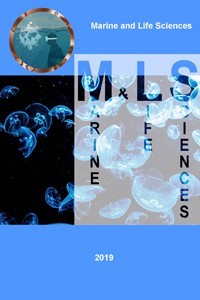Doğadan toplanan Tubifex tubifex’ in mikrobiyal yük seviyesinin kontrollü laboratuvar şartlarında değişimi
Tubifex tubifex, Yetiştiricilik, Mikrobiyoloji, Maya-küf, Pseudomonas/aeromonas, Koliform bakteri, Mezofil/psikrofil bakteri
Temporal variation of microbial load under controlled laboratory conditions of Tubifex tubifex collected from nature
Tubifex tubifex, Culture, microbiology, Yeast-mold, Pseudomonas/aeromonas, Coliform bacteria, Mesophile/ psycrophile bacteria,
___
- Beauchamp, K. A., Gay, M., Kelley, G. O., El-Matbouli, M., Kathman, R. D., Nehring, R. B. & Hedrick, R. P. (2002). Prevalence and susceptibility of infection to Myxobolus cerebralis and genetic differences among populations of Tubifex tubifex. Diseases of Aquatic Organisms, 51: 113-121.
- Beauchamp, K. A., El-Matbouli, M., Gay, M., Georgiadis, M. P., Nehring, R. B. & Hedrick, R. P. (2006). The effect of cohabitation of Tubifex tubifex (Oligochaeta: Tubificidae) populations on infections to Myxobolus cerebralis (Myxozoa: Myxobolidae). Journal of Invertebrate Pathology, 91(1): 1-8.
- Brinkhurst, R. O. & Jamieson, B. G. M. (1971). Aquatic Oligochaeta of the world. Oliver and Boyd, Edinburgh.
- Chekanovskaya, O. V. (1981). Aquatic Oligochaeta of the USSR. Amerind Publishing Company. New Delhi.
- Çelik, P. (2018). Sediment yapısının Tubifex tubifex’in biyokimyasal kompozisyonu üzerine etkisi. International Eurasian Conference on Biological and chemical Sciences, 26-27 April 2018, Ankara. Proceeding Book 129-134 pp.
- Elibol, M. İ., Üstündağ, S. & Çevlik, H. (2006). Eğrekkaya Baraj Gölü limnolojisi, I. Balıklandırma ve Rezervuar Yönetimi Sempozyumu, Antalya, pp:447-452.
- El-Mansy, A. (1998). Development of Myxobolus portucalensis Saraiva and Molnár, 1990 (Myxosporea: Myxobolidae) in the oligochaete Tubifex tubifex (Müller). Systematic Parasitology, 41(2): 95-103.
- El-Matbouli, M. & Hoffman, R. W. (1989). Experimental transmission of two Myxobolus spp. developing bisporogeny via Tubificid Oligochaetes. Parasitology Research, 75: 461-464.
- El-Matbouli, M. & Hoffman, R. W. (1995). Light and electron microscopic observations on the route of the triactinomyxonssporoplasm of Myxobolus cerebralis from epidermis into Rainbow trout cartilage. Journal of Fish Biology, 46: 919-935.
- Eszterbauer, E., Székely, C., Molnár, K. & Baska, F. (2000). Development of Myxobolus bramae (Myxosporea: Myxobolidae) in an oligochaete alternate host, Tubifex tubifex. Journal of Fish Diseases, 23(1): 19-25.
- Famme, P. & Knudsen, J. (1984). Total heat balance study of anaerobiosis in Tubifex tubifex (Müller). Journal of Comparative Physiology B, 154(6): 587-591.
- Kaeser, A. J. & Sharpe, W. E. (2006). Patterns of distribution and abundance of Tubifex tubifex nd other aquatic oligochaetes in Myxobolus cerebralis enzootic areas in Pennsylvania. Journal of Aquatic Animal Health, 18(1): 64-78.
- Lang, C. & Lang-Dobler, B. (1980). Structure of tubificid and lumbriculid communities, and three indices of trophy based upon these communities, as descriptors of eutrophication level of Lake Geneva (Switzerland). In R. O. Brinkhurst & D. G. Cook (eds), Aquatic Oligochaete Biology. Plenum Publishing Corporation, New York: 457–470.
- Lazim, M. N. & Learner, M. A. (1986). The life‐cycle and productivity of Tubifex tubifex (Oligochaeta; Tibificidae) in the Moat-Feeder Stream, Cardiff, South Wales. Ecography, 9(3): 185-192. Markiw, M. E. & Wolf, K. (1983). Myxosoma cerebralis (Myxozoa: Myxosporea) etiologic agent of salmonid whirling disease requires Tubificid Oligochaetes (Annelida: Oligochaetes) in its life cycle. The Journal of Protozoology, 30: 561-564.
- Milbrink, G. (1978). Indicator communities of oligochaetes in Scandinavian lakes. Internationale Vereinigung für theoretische und angewandte Limnologie, Verhandlungen, 20(4): 2406-2411.
- Milbrink, G. (1980). Oligochaete communities in pollution biology. The European situation with special reference to lakes in Scandinavia. In R. O. Brinkhurst & D. G. Cook (eds), Aquatic Oligochaete Biology. Plenum Publishing Corporation, New York: 433–455.
- Milbrink, G. (1987). Biological characterization of sediments by standardized tubificid bioassays. Hydrobiologia, 155: 267-275.
- Peters, W. (1977). Possible sites of ultrafiltration in Tubifex tubifex Müller (Annelida, Oligochaeta). Cell and Tissue Research, 179(3): 367-375.
- Sarkka, J. (1987). The occurrence of oligochaetes in lake chains receiving pulp mill waste and their relation to eutrophication on the trophic scale. Hydrobiologia, 155: 259-265.
- Steen Redeker, E., Bervoets, L. & Blust, R. (2004). Dynamic model for the accumulation of cadmium and zinc from water and sediment by the aquatic oligochaete, Tubifex tubifex. Environmental Science and Technology, 38(23): 6193-6200.
- Şahin, S. K. & Yıldız, S. (2011). Species distribution of oligochaetes related to environmental parameters in Lake Sapanca (Marmara Region, Turkey), Turkish Journal of Fisheries and Aquatic Sciences, 11(3): 359-366.
- Tanyolaç, J. (1993). Limnoloji, Hatiboğlu Yayınları, Ankara, pp: 294.
- Wolf, K., Markiw, M. E. & Hiltunen, J. K. (1986). Salmonid whirling disease: Tubifex tubifex (Müller) identified as the essential oligochaete in the protozoan life cycle. Journal of Fish Diseases, 9(1): 83-85.
- Yanar, M., Yanar, Y. & Genç, M. A. (2003). Tubifex tubifex Müller, 1774 (Annelidae)’in Besin Kompozisyonu, Ege Üniversitesi Su Ürünleri Dergisi, 20(1-2): 103-110.
- Yayın Aralığı: Yılda 2 Sayı
- Başlangıç: 2019
- Yayıncı: Emrah ŞİMŞEK
Hatice SÖNMEZ, Metin YAZICI, Selmin ÖZER
Mohammad Amzad HOSSAİN, Ahmad Fazley RABBY
İnovatif doğal medikal ürünler için bazı denizel makroalglerin değerlendirilmesi
Nurdan ÜNAL, Aycan ARAS, Oğulcan HABİBOĞLU, Sinem UĞUR, Mehmet NAZ, Selin SAYIN
Ferhat BUYUKDEVECİ, Osman SAMSUN, Uğur ÖZSANDIKÇI
Karadeniz’de deneysel sepet tasarımlarının av verimi ve av kompozisyonunun karşılaştırılması
Yakup ERDEM, Utku Samet ÖKSÜZ, Osman SAMSUN
Eisenia fetida (Savigny 1826)’da mikroplastik maruziyetinin büyüme parametreleri üzerine etkisi
Elif MENTEŞ, Sukran YALÇIN OZDİLEK
Orta Karadeniz (Sinop-Samsun) kıyı balıkçılığında kullanılan av araçlarının teknik planları
Yakup ERDEM, Süleyman ÖZDEMİR, Uğur ÖZSANDIKÇI, Ferhat BUYUKDEVECİ
Türkiye denizleri için Uskumru balığının (Scomber scombrus Linnaeus, 1758) maksimum boy kaydı
